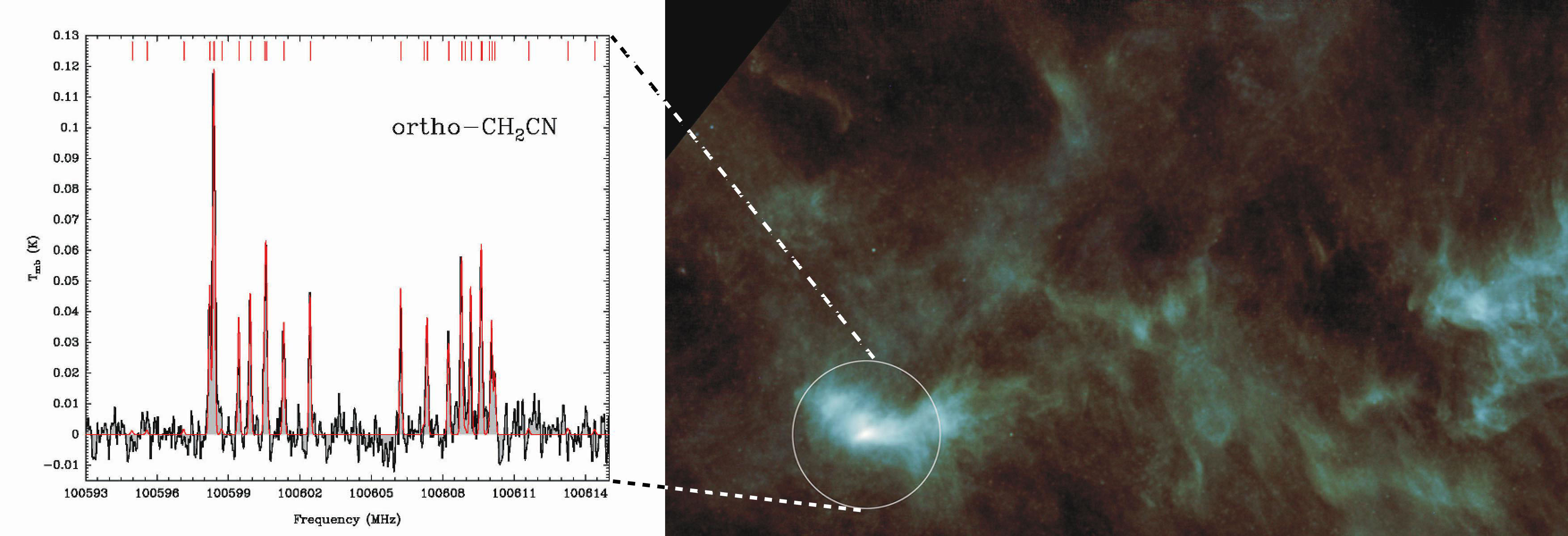News
IRAM reveals a large reservoir of organic material in the starless core L1544
Placed in the Taurus star forming region, at about 450 light-years from Earth, L1544 is the prototype of prestellar cores, the cold gas condensations on the verge of collapsing to form new stars. An unbiased frequency survey of this dense core has been carried out with the IRAM 30-m radiotelescope, as a part of the Large Program ASAI (Astrochemical Surveys at IRAM; Lefloch, Bachiller et al. 2015), and has recently been used by Vastel et al. (2014, 2015) to provide the full census of oxygen bearing complex organic molecules (COMs) in its central region. As an example, Figure 1 shows the richness of the spectrum in the frequency range from 81 to 89 GHz, together with the identification of the most prominent lines.
.jpg) |
| Figure 1.- The interval of the ASAI frequency survey of L1544 from 81 to 89 GHz revealing lines of, among other, several complex organic molecules. |
Tricarbon monoxide (C3O), methanol (CH3OH), acetalhehyde (CH3CHO), formic acid (HCOOH), ketene (H2CCO) and propyne (CH3CCH) were detected with abundances ranging from 5x10-11 to 5x10-9. In order to explain the methanol abundance, the authors argue that the ices where methanol has formed are desorbed through non-thermal processes in an outer layer of the dense core where the far ultraviolet radiation can penetrate. They also suggest that it is likely that the other COMs detected and also water (previously detected with Herschel, Caselli et al. 2012, ApJLett 759, L37) have the same origin. Chemical models confirm that the desorbed oxygen and tiny amounts of methanol and ethene (C2H4) are enough to explain all the observed abundances.
 |
|
Figure 2.- Left.- Observed lines of ortho-CH2CN around 100.6 GHz superimposed to a model LTE spectrum (red) from Vastel et al. (2015). Right.- the L1544 region observed in the mid infrared with the Herschel Observatory (ESA/Herschel/SPIRE). |
Even more recently, complex spectral patterns near 101 GHz, for which the authors suspected the presence of hyperfine structure, have been identified with lines of the ortho and para forms of the cyanomethyl radical (CH2CN). For this identification, the frequency and line strengths for both ortho and para species have been computed. One of such high- resolution spectra is shown in Figure 2, its noise level is below 3 mK. This is the first detection of the resolved fine and hyperfine structure of such lines in a dense core.
All in all, these ASAI observations reveal a very rich organic content in the L1544 prestellar core. Although it is difficult to predict all the chemical processes to which these organic molecules will be subjected during the formation of a new star and planetary system, at the view of these rich molecular spectra it is tempting to suggest that the prebiotic chemistry can be rooted in the interstellar medium, at very early stages of the star formation process.
Read more :
Lefloch, Bachiller, et al. (2015) 'ASAI: The astrochemical evolution from interstellar clouds to young stellar objects', IAU GA Symposium 315.
Vastel, Ceccarelli, Lefloch & Bachiller (2014) 'The Origin of Complex Organic Molecules in Prestellar Cores'. ApJ Lettters 795, L2
Vastel, Yamamoto, Lefloch & Bachiller (2015) 'Hyperfine structure of the cyanomethyl radical (CH2CN) in the L1544 prestellar core'. A&A Letters, in press

